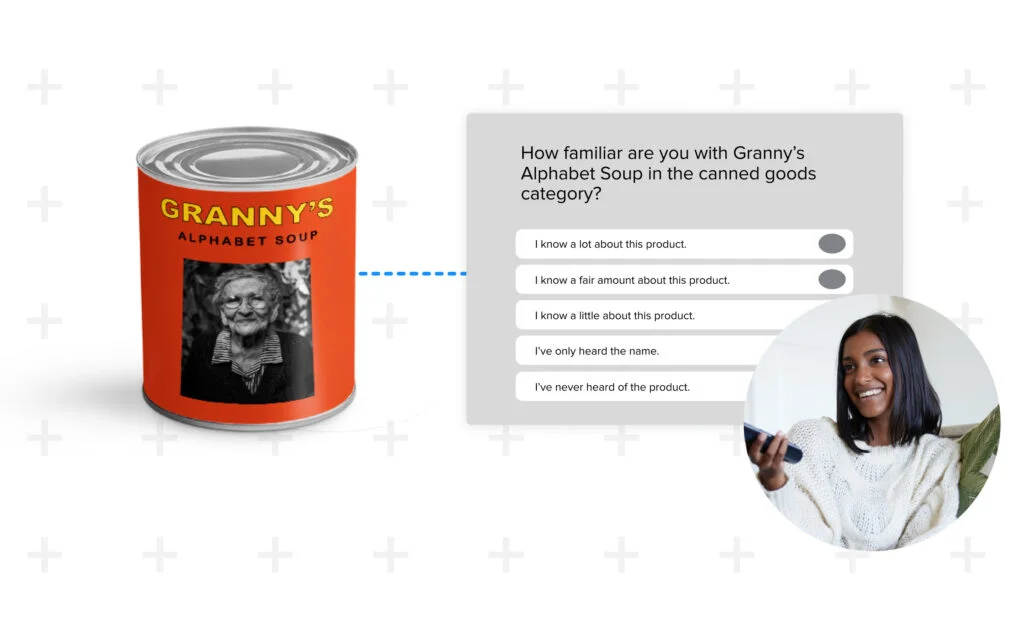Alphabet Soup: The A-F-Cs of Brand Lift

Written By
Franni Segal

To understand the impact of a creative, brand lift survey questions that measure ad recall and awareness, familiarity and favorability, and consideration and competitors are key.
Trying to explain why you buy from a brand is like trying to describe your grandmother’s soup. You know you like it. You feel warm and fuzzy when you think about it. You know the recipe. And yet, trying to distill it down to a simple explanation is impossible.
Recipe for Success
If you can’t explain it, then measuring media impact on consumer brand perception is even harder. Advertisers rely on brand lift studies to assess attitudinal changes that are happening as a result of exposure to the advertising messages. This type of measurement allows marketers to answer questions such as:
- Did exposure to an ad shift awareness of a particular product?
- What was the number of impressions it took to shift those attitudinal changes?
- Does the ad clearly communicate branding or is there a halo effect on other competitor brands?
- Did the reason provided in a creative shift the opinion of a consumer about a brand?
- Were there enough descriptions of the product to put the brand in a consumer consideration set?
The A-F-Cs
The key to measuring the impact of a creative is understanding the objective behind its message and aligning the survey question accordingly. Depending on the ad’s intended marketing funnel stage, different questions measuring ad recall and awareness, familiarity and favorability, and consideration and competitors will help provide insight into its impact on customer perception.
We’ll take a minute to go through the types of questions that help you measure the A-F-Cs of brand lift:
A
Ad Recall
Do you recall seeing an ad for X brand?
There are a variety of ways to measure the awareness stage. At its simplest point, we can ask an ad recall question, accessing if an ad was consciously recalled. This type of question could be relevant across multiple creative objectives, but it is especially relevant in new media such as connected TV (CTV) when the survey is being administered on a different device. This type of question also can be used to understand how strong the branding is communicated, irrespective of whether the ad is communicating what it is intended to or if the viewer likes the ad. If a client is looking to assess message interpretation and likeability, many times we recommend our clients run this in combination with a second question.
Awareness
Standard awareness questions can be asked in three ways.
Which of the following brands in the Y category are you aware of?
This question is the recommended awareness question, as it provides two sources of insight: it helps a client understand how well the ad drives brand awareness and assesses the halo awareness of competitor brands. While the instinct is to include the largest brand names in your survey question, these household names will automatically be recognized. If a smaller mom-and-pop brand decides to include their name alongside established brands such as Campbell’s, they should remember that recognition may be exponentially higher for these brands even without advertising because we are not asking the potential customer if they are buying the established brand, just if they are aware of them. We recommend that you pick brands that both fit the category and your brand’s size.
Are you aware of X brand in the Y category?
This second question assesses baseline awareness and how well an ad might impact a brand with no comparisons. This type of question works well with a true branding ad that has a clear logo and/or verbal reference to the brand but doesn’t have too many other elements to remember in the ad. That said, it is often seen as a leading question since the brand name is prominently featured, so it is only recommended for emerging or little known brands. For a new product or brand launch, this question can help establish whether your ad broke through the noise.
Which of the following benefits of X brand are you aware of?
As a bonus option, there is a third useful way to assess product benefits awareness. This question is most useful in understanding whether features of a product highlighted in the creative copy are landing with the customer. In this example, did customers remember that Granny’s Alphabet Soup is organic, low sodium, high fiber, and made with love?
F
Familiarity
How familiar are you with X brand in Y category?
Moving down the funnel, familiarity questions allow advertisers to understand if a viewer is just remembering the name or the scale of information they have retained about a particular brand, product, or category. While this is very much an emotional question, for feel-good brands familiarity is a key reason consumers buy. Familiarity questions can help marketers understand:
- How much information a consumer is retaining from ad exposure
- Which level of familiarity is driving the greatest brand lift
- What ideal frequency is associated with each level of familiarity
- Which creative is driving maximum awareness to learn more
Favorability
What is your opinion of X brand in Y category?
This question type is used to assess if the creative shifted the appeal of a brand, product, or category. The biggest mistake we see in favorability questions is using a pure brand creative with a logo and picture and expecting this to shift opinions of the brand, so creative is a critical strategic consideration. There are two main ways to shift favorability within a creative: appealing to consumers with brand connection or features and benefits. To drive a shift in consumer brand connection, this often is a great question to ask if there is humor or personality integrated into the ad or if the brand is involved in a charity initiative and wants to understand consumer sentiment. For features and benefits shifts, creative highlighting the recyclable materials used to make a product or sponsoring a share of profits to benefit the disabled works well.
C
Consideration
When in the market for Z product, how likely are you to consider the X brand?
Consideration questions are the most often requested and misused by marketers. A logo and brand image is not enough to drive consideration; this only tells a consumer the brand or product exists. Instead, a good consideration ad features compelling reasons for buying the product, pushing them into the consumer’s consideration set. This can include highlighting key differentiators paired with pre-purchase elements such as special incentives or offers, general pricing, or where to buy the product.
Competitors
The next time you are in the market for Z product, which will you consider?
A competitive consideration question provides a wealth of insight into how your brand stacks up against competitive brands, highlighting:
- Is ad exposure positively shifting consumers to consider your brand over competitors?
- Who are your main competitors and how do they rank?
- Where are you stealing market share?
- Is your greatest brand lift coming from brand defectors or consumers with no brand allegiance?
- Was there a positive halo impact of competitors to the category, highlighting that your creative isn’t working and included unclear branding?
Home Sweet Home: Homing in on your most influenceable audience
While marketers can never fully quantify brand sentiment, they can use the brand lift question A-F-Cs to better understand consumer shifts in brand perception. At Quantcast, we believe that brand lift shouldn’t just be a measurement tool, but also one that helps marketers home in on their core audiences. With Brand Lift Live by Quantcast™, marketers can see the live impact of their brand advertising, optimizing their campaigns across frequency, creative messaging, and audiences to maximize that warm and fuzzy feeling that is Granny’s Alphabet Soup.
Learn more
Find out how Auto Trader and Sky used Brand Lift Live to fine-tune their campaigns and maximize campaign effectiveness. To learn more about brand advertising campaigns that deliver measurable results, read this blog post.
Share article
Measure what matters

